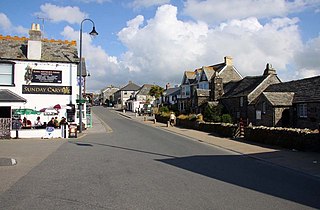
Tintagel or Trevena is a civil parish and village situated on the Atlantic coast of Cornwall, England. The village and nearby Tintagel Castle are associated with the legends surrounding King Arthur and in recent times has become a tourist attraction.

Tintagel Castle is a medieval fortification located on the peninsula of Tintagel Island adjacent to the village of Tintagel (Trevena), North Cornwall in the United Kingdom. The site was possibly occupied in the Romano-British period, as an array of artefacts dating from this period have been found on the peninsula, but as yet no Roman-era structure has been proven to have existed there. It was settled during the early medieval period, when it was probably one of the seasonal residences of the regional king of Dumnonia. A castle was built on the site by Richard, 1st Earl of Cornwall in the 13th century, during the High Middle Ages. It later fell into disrepair and ruin.

The River Camel is a river in Cornwall, England. It rises on the edge of Bodmin Moor and with its tributaries its catchment area covers much of North Cornwall. The river flows into the eastern Celtic Sea between Stepper Point and Pentire Point having covered about 30 miles, making it the second longest river wholly in Cornwall. The river is tidal upstream to Egloshayle and is popular for sailing, birdwatching and fishing. The name Camel comes from the Cornish language for 'the crooked one', a reference to its winding course. Historically the river was divided into three named stretches. Heyl was the name for the estuary up to Egloshayle, the River Allen was the stretch between Egloshayle and Trecarne, whilst the Camel was reserved for the stretch of river between its source and Trecarne.

North Cornwall is an area of Cornwall, England, United Kingdom. It is also the name of a former local government district, which was administered from Bodmin and Wadebridge 50.516°N 4.835°W. Other towns in the area are Launceston, Bude, Padstow, and Camelford.

Treknow is a small village in Tintagel civil parish, Cornwall, England, United Kingdom: it is the second largest settlement, and is located between Trevena and Trebarwith. It is situated 19 miles (31 km) north of Bodmin, 4 miles (6.4 km) north-west of Camelford, and 1 mile (1.6 km) west of Tintagel, grid reference SX056869
Bossiney Haven is a small cove in the civil parish of Tintagel. It is on the north coast of Cornwall, United Kingdom and a mile east of Tintagel and three miles west of Boscastle. The South West Coast Path closely follows the coast above the cove.
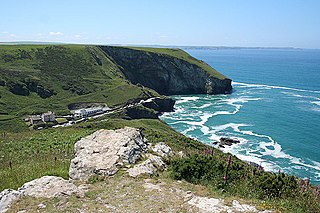
Trebarwith Strand is a section of coastline located near the coastal settlement of Trebarwith on the north coast of Cornwall, England, UK, 2+1⁄2 miles (4.0 km) south of Tintagel. It has 800m of sandy beach contained by cliffs in which natural caves are found. The beach can only be accessed at low tide. The strand was once used to land ships to export slate from the nearby quarries while sand from the beach was used for agricultural purposes. The view from the beach is dominated by rocks 300m offshore known as Gull Rock or Otterham Rocks.

Beer Quarry Caves is a man-made limestone underground complex located about a mile west of the village of Beer, Devon, and the main source in England for beer stone. The tunnels resulted from 2,000 years of quarrying beer stone, which was particularly favoured for cathedral and church features such as door and window surrounds because of its colour and workability for carving. Stone from the quarry was used in the construction of several of southern England's ancient cathedrals and a number of other important buildings as well as for many town and village churches, and for some buildings in the United States. Extraction was particularly intense during the Middle Ages, but continued until the 1920s. An adit to another set of workings can be seen from the South West Coast Path east of Branscombe, having been exposed by a landslip in the late 18th century. The quarry is part of the Jurassic Coast, and is a Site of Special Scientific Interest (SSSI).
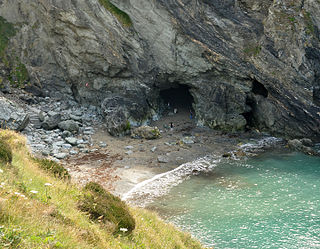
Merlin's Cave is a cave located beneath Tintagel Castle, 5 kilometres (3.1 mi) south-west of Boscastle, Cornwall, England. It is 100 metres (330 ft) long, passing completely through Tintagel Island from Tintagel Haven on the east to West Cove on the west. It is a sea cave formed by marine erosion along a thrust plane between slate and volcanic rocks. The cave fills with water at high tide, but has a sandy floor and is explorable at low tide.

Gallos is an 8-foot-tall (2.4 m) bronze sculpture by Rubin Eynon located at Tintagel Castle, a medieval fortification located on the peninsula of Tintagel Island adjacent to the village of Tintagel (Trevena), North Cornwall, in the United Kingdom. It is a representation of a ghostly male figure wearing a crown and holding a sword. It is popularly called the "King Arthur statue", but the site's owner English Heritage states that it is not meant to represent a single person and reflects the general history of the site, which is likely to have been a summer residence for the kings of Dumnonia.
Long Grass Quarry is a small, disused slate quarry between Tintagel and Trebarwith on the north coast of Cornwall, South West England, which was worked up until 1937. It was the last of the slate quarries on this stretch of coast to be abandoned.
Bagalow Quarry is a disused slate quarry between Tintagel and Trebarwith at Bagalow Cove on the north coast of Cornwall, South West England. The quarry was worked from the 1830s into the early part of the twentieth century.
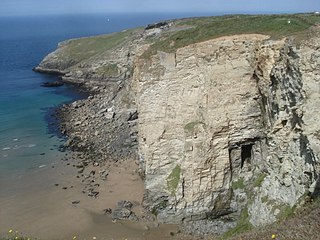
Caroline Quarry is a disused slate quarry between Tintagel and Trebarwith on the north coast of Cornwall, South West England. The quarry was worked until the early part of the twentieth century.
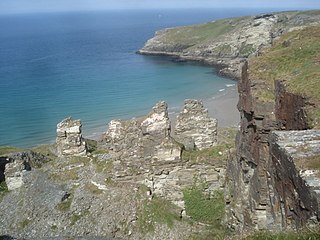
Tintagel Slate Quarries fall into two categories: the series of quarries lying between Tintagel Castle and Trebarwith Strand on the north coast of Cornwall, South West England and the open cast quarries further inland. There are around eight cliff-edge quarries as well as two wharfs, all of which are now disused as well as four inland sites, two of which are still in operation. The first quarry to be worked appears to have been Lanterdan at some point in the fifteenth century, while the last of the coastal quarries, Long Grass ceased operations in 1937. The remains of the coastal quarries occupy coastal land owned by the National Trust and most are easily accessible from the South West Coast Path. The Prince of Wales Quarry has been turned into a country park by North Cornwall District Council.

Hole Beach is a bathing and surf beach just north of Trebarwith Strand on the North Coast of Cornwall, South West England. The beach can be accessed from Trebarwith at low tide or by a zigzagging quarryman's track from the village of Treknow. The beach is sandy and the water is good for surfing. The sheer cliffs to the north of the beach form part of the now disused Caroline Slate Quarry and were created by quarrymen suspended by ropes attached to strongpoints some 75m on the clifftop above. A cave 15m above sea level is artificial and is also the result of quarrying- this is the "hole" that gives the beach its name. There is also a natural sea cave at the rear of the beach. One of the stone strong points still perches on top of the near vertical cliffs 75m above the beach, as does a second building which was possibly used as a toolshed.
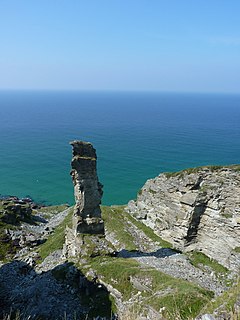
Lanterdan Quarry is a disused open cast slate quarry between Tintagel and Trebarwith on the north coast of Cornwall, South West England. The quarry is the oldest, largest and most spectacular of Tintagel’s coastal quarries and was worked from the fifteenth until the early twentieth century. A distinguishing feature of the quarry is a 25m high pinnacle of inferior slate.
Penhallick Wharf is a disused coastal loading dock between Tintagel Castle and Trebarwith Strand on the north coast of Cornwall in South West England. The wharf served the Tintagel Slate Quarries, particularly those without easy access to the loading beach at Tintagel Haven. These include Caroline, Dria, Bagalow and possibly Lambshouse and Gull Point quarries.

West Quarry is a disused open cast slate quarry between Tintagel and Trebarwith on the north coast of Cornwall, South West England. The quarry ceased operations towards the end of the nineteenth century.

50.674°N 4.741°W














